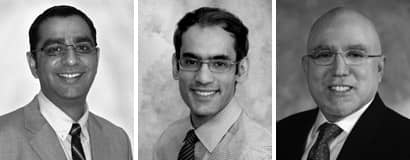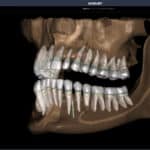A long-term evaluation for Class II correction
By Aditya Chhibber, BDS, MDS
Madhur Upadhyay, BDS, MDS, MDentSc
Ravindra Nanda, BDS, MDS, PhD
A Class II malocclusion is one of the most commonly encountered problems in orthodontics, whether due to a skeletal or dental discrepancy. It has been suggested1 that mandibular retrognathism is more often the reason for the skeletal discrepancy than maxillary prognathism.
Based on the patients’ growth status, treatment options commonly include use of functional/fixed functional appliances (FFAs) to try to possibly enhance the mandibular growth, headgear to restrict maxillary growth and/or distalize the upper molars, camouflage by extraction of upper and or lower premolars, or surgical correction of the underlying skeletal discrepancy when facial growth has completed. Functional appliances are often the preferred modality of treatment in growing Class II patients with mandibular deficiency. Among these appliances, semi-rigid FFAs are gaining popularity as patient compliance may be better with such fixed FFAs than with removable functional appliances.2
It is generally agreed that teeth that have been moved tend to return to their former position. Pancherz3 studied retention with the rigid Herbst appliance and stated that most of the relapse that occurred was from the dental changes. Therefore, maintenance of treatment results is the true hallmark of the effectiveness and efficacy of any particular orthodontic appliance.
The long-term results obtained with semi-rigid FFAs are still largely unknown. In the past, some case reports4 have demonstrated that the corrections achieved by these semi-rigid mandibular repositioning appliances are stable over long periods. The following cases highlight the efficacy of the Twin Force bite corrector (TFBC) appliance, a semi-rigid FFA in successful correction of Class II deep-bite malocclusion, with long-term evaluation of the corrections achieved.
Design and Biomechanics

The center of resistance of the upper and lower arch is considered to be in between the apex of the first and second premolar roots. The direction of force applied by a FFA on the maxillary denture base would be distal and intrusive, while the lower arch experiences a mesial and intrusive force. The forces delivered also produce a clockwise rotation of both arches, which can lead to canting of the occlusal plane. However, since the TFBC appliance is attached mesial to the upper molar, it thereby reduces the distance between the point of force application and the center of resistance of the upper arch, causing lesser moment to be generated as compared to other bite jumping appliances where the point of application of the force is distal to the upper molar (Figure 2). This further results in maintaining or minimizing the steepening of the occlusal plane and maintaining the vertical dimension of the face.
Treatment Protocol

Additionally, to minimize the lower incisor flaring, lower anterior brackets with a torque prescription of -6° are recommended. The standard TFBC version is attached by the hex nuts onto the archwires mesial to the maxillary molars and distal to the lower canines, posturing the mandible forward in an edge-to-edge occlusion. After 3 to 4 months of appliance wear, the patients are overcorrected to a super Class I relation to compensate for mild relapse which would occur after removal of the appliance. The TFBC appliance is then removed, and intermaxillary elastics are used to maintain the correction achieved. Finishing and detailing of the occlusion is performed as per individual case requirements.
Effects of TFBC Appliance


Case with Long-Term Results

Conclusion

 |
| Aditya Chhibber, BDS, MDS, is a resident in the orthodontics division of the department of Craniofacial Sciences at the University of Connecticut Health Center. He can be reached at [email protected].
Madhur Upadhyay, BDS, MDS, MDentSc, is assistant professor in the orthodontics division of the department of Craniofacial Sciences at the University of Connecticut Health Center. He can be reached at [email protected]. Ravindra Nanda, BDS, MDS, PhD, is professor and head of the department of Craniofacial Sciences at the University of Connecticut Health Center. He can be reached at [email protected]. |
References
- Ngan PW, Byczek E, Scheick J. Longitudinal evaluation of growth changes in class II division 1 subjects. Semin Orthod. 1997;3:222-331.
- O’Brien K, Wright J, Conboy F, et al. Effectiveness of treatment for Class II malocclusion with the Herbst or Twin-block appliances: A randomized, controlled trial. Am J Orthod Dentofacial Orthop. 2003;124:128-137
- Pancherz H. The nature of Class II relapse after Herbst appliance treatment: A cephalometric long-term investigation. Am J Orthod Dentofacial Orthop. 1991;100:220-233.
- Chhibber A, Upadhyay M, Uribe F, Nanda R. Long-term stability of Class II correction with the Twin Force Bite Corrector. J Clin Orthod. 2010;44:363-376.
- Chhibber A, Upadhyay M, Uribe F, Nanda R. Mechanism of Class II correction in prepubertal and postpubertal patients with Twin Force Bite Corrector. Angle Orthod. 2012 Nov 29. [Epub ahead of print].
- Guimaraes CH Jr, Henriques JFC, Janson G, et al. Prospective study of dentoskeletal changes in Class II division malocclusion treatment with twin force bite corrector. Angle Orthod. 2013;83(2):319-326.
- Uribe F, Rothenberg J, Nanda R. The Twin force bite corrector in the correction of Class II maloclussion in adolescent patients. In: Papadopoulos MA, ed. Orthodontic Treatment of the Class II Noncompliant Patient. 2006; Elsevier; 181-202.
- Campbell E. A prospective clinical analysis of a push-type fixed intermaxillary Class II correction appliance, thesis, University of Connecticut, Farmington, 2003.










